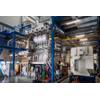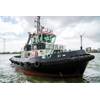J-ENG Starts Testing Ammonia-Fueled 2-Stroke Engine, Hydrogen Injectors
Japan Engine Corporation (J-ENG) has started testing a large low-speed 2-stroke engine fuelled by ammonia as part of its development project with the New Energy and Industrial Technology Development Organization (NEDO).
The test engine installed at the Mitsubishi Heavy Industries Research and Innovation Center in Nagasaki has been fitted with J-ENG’s stratified injection system. The injection system aims to ensure that the ammonia burns efficiently to minimize the generation of nitrous oxide (N₂O), and the ammonia co-firing ratio can be set to different levels depending on future progress in the development of ammonia fuel infrastructure, ammonia fuel price and trends in environmental regulations.
A new facility to supply ammonia fuel to the test engine has been installed adjacent to the building housing the test engine, and the experience gained from the operation of this facility will be fed back to the development of ammonia fuel supply systems for ships.
The ammonia testing will be conducted over the coming year. In parallel, J-ENG will design and manufacture a full-scaled ammonia fueled demonstration engine. This is scheduled to be completed in September 2025 after about six months of shop operation for verification.
In further developments, J-ENG has started testing its hydrogen fuel injection system at its head office plant in Akashi city. Hydrogen fuel is easy to ignite and burns very quickly, so the research will focus on ensuring stable combustion. J-ENG is currently developing high-pressure injection technology where the hydrogen is injected directly when the combustion chamber reaches high temperature and pressure. This is designed as an electric ignition system to improve environmental performance.
Over a year of testing is planned before the company proceeds with the development of a full-scale hydrogen fueled engine for demonstration. This is scheduled to be completed in March 2027.













